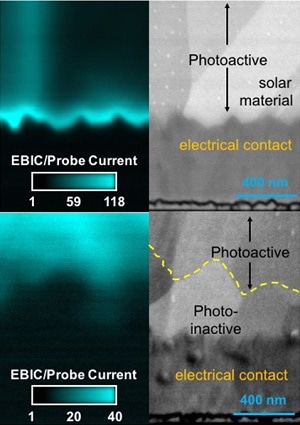Aug 4 2016
 The entire solar material for the sample with less than or equal to 30 percent selenium is photoactive (top) while the bottom of the solar material for the image below contains greater than 35 percent selenium and has reduced photoactivity. (credit: ORNL)
The entire solar material for the sample with less than or equal to 30 percent selenium is photoactive (top) while the bottom of the solar material for the image below contains greater than 35 percent selenium and has reduced photoactivity. (credit: ORNL)
Research work carried out at the Department of Energy’s Oak Ridge National Laboratory could help cadmium-tellurium-based solar cells to achieve their theoretical levels of efficiency.
Using sophisticated microscopy techniques, a research team headed by Jonathan Poplawsky of the Center for Nanophase Materials Sciences discovered efficiency differences of crystalline structures of different mixtures of selenium, tellurium, and cadmium. Selenium is an integral element of the formulation that led to record-breaking solar cell efficiency.
The researchers have reported their findings in a paper, titled Structure and Compositional Dependence on the CdTexSe1-x Alloy Layer Photoactivity in CdTe-based Solar Cells in the Nature Communications journal.
A mixture of tellurium and cadmium is used in some of the existing solar cells to transform solar energy into electrical energy.
Now, the addition of selenium in an optimum amount in the right regions could help improve the conversion efficiency from the current level of 22% to levels close to the theoretical limit of 30% to 33%. To achieve this, it is important to identify the best ratio of selenium.
Using different microscopy methods, we were able to gain a better understanding of the phases, compositions and crystalline structures that allow these materials to convert light into electricity more efficiently. In some instances, adding too much selenium changes the crystalline structure of cadmium-tellurium and dramatically reduces the conversion efficiency.
Jonathan Poplawsky, Center for Nanophase Materials Sciences
The research team investigated four solar cells with varying selenium contents in this study and also explored the corresponding alterations in their crystalline structure.
What the researchers found was that the solar cells with the highest or lowest levels of selenium had inferior performance. They observed the best performance for the alloy composition consisting of 50% cadmium, 25% selenium, and 25% tellurium.
The research team determined the best ratio of selenium using a combination of analytical methods, including electron beam induced current, transmission electron microscopy, and atom probe tomography at the CNMS, a DOE Office of Science User Facility.
We have shown that the amount of selenium incorporated into the cadmium-tellurium controls whether the small crystals inside the solar cell form as crystal structure A or crystal structure B. This information can be used as a roadmap for solar cell producers to make improved cadmium-tellurium solar cells that use selenium additions, and hopefully increase the overall efficiency.
Jonathan Poplawsky, Center for Nanophase Materials Sciences
Poplawsky explained that silicon is typically used in solar cells to convert light energy into electrical energy. However, cadmium-telluride is capable of absorbing the amount of sunlight using 98% less semiconducting material compared to silicon, thereby lowering the overall cost of solar panels. Solar panels consisting of cadmium, selenium, and tellurium are more competitive, compared to other forms of electricity generation.
ORNL co-authors on the paper include Wei Guo, Karren More, and Donovan Leonard.
DOE’s SunShot Initiative in partnership with the National Sciences Foundation funded this study.